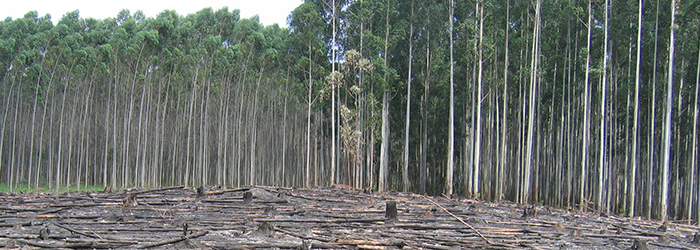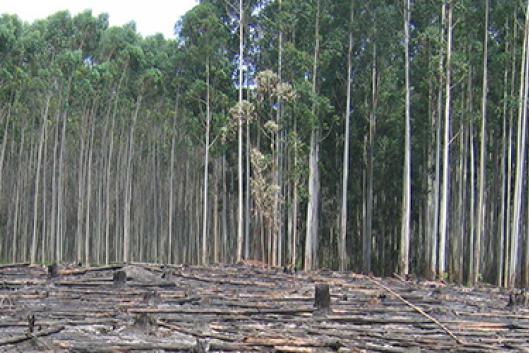Many communities in countries in the Global South are fighting invasion of their lands by large-scale tree plantations. WRM has learned a lot from them. One thing we have learned is that no plantation of this kind can exist without considerable subsidies and/or incentives from public or private institutions. In the current scenario of economic and climate structural crises, plantation companies have identified a new stimulus: to implement one of the main actions that emerged from the 2016 Paris Climate Agreement and on a territorial scale never seen before. That is, to remove "excess" carbon from the atmosphere that causes global warming and store it in trees.
In the last two decades, the area occupied by large-scale monoculture tree plantations in the Global South has expanded no less than four times, reaching 60 million hectares in 2012. (1) These eucalyptus, pine, acacia, oil palm and rubber trees are mostly for (respectively): pulp, palm oil-based products, and car tires. Major contributors driving this dramatic expansion, as compared to the North, include the cheaper land and manual labor, a more favorable climate for rapid growth and greater productivity of timber, strong media support, and political support by governments of Southern countries, including a repressive State apparatus which—instead of supporting them—have criminalized local communities' struggles to defend their territories.
But the prolonged economic crisis has slowed the pace of this expansion, and consequently corporate profits. From the standpoint of communities, companies in search of alternatives have seen the climate crisis as a new array of opportunities for years—for example, the opportunity to charge for the "service" trees provide by removing CO2 from the atmosphere. Indeed, trees absorb atmospheric CO2 through photosynthesis as they grow, and some of that carbon is "stored" in the wood. Companies argue that their trees provide this "service" increasingly better, because the trees are growing faster than before, and the introduction of transgenic trees promises even greater productivity. Companies also believe they could receive incentives to plant trees for biomass (by transforming wood into "wood pellets"). Burning these "pellets" instead of oil or coal would be "renewable" and "green" energy. In addition, large oil palm plantation companies, especially in Indonesia and Malaysia, offer palm oil as a "biofuel" option.
Increasingly, companies are betting on a "flexible" use of their plantations, seeing opportunities to get multiple and even simultaneous uses out of their crops: on the one hand carbon "sinks," and on the other hand raw material for pulp (eucalyptus, pine, acacia), for tires (rubber tree), or for vegetable oil (oil palm). But with the obvious need to cut down the tree at some point to produce short-lived products—such as paper, tires or oil—the stored carbon is quickly emitted, long before new trees could recapture it, in the event the company chooses to replant. For this reason, in order for reforestation to be more effective at "removing" atmospheric carbon, the first step would be to make it permanent. (2)
What does the Paris Agreement say about monoculture tree plantations?
The text of the Paris Agreement does not explicitly mention tree plantations, but it indirectly creates the conditions for this to be one of the most benefited sectors. How?
First of all, plantation companies take advantage of the fact that the FAO's definition of forests includes monoculture tree plantations. Internationally, this is a more acceptable definition—including by the Paris Agreement—and is used by almost all national governments and UN initiatives, such as the UN Convention on Climate and Biodiversity. The FAO considers any area merely with trees to be a forest. Yet plantations—unlike forests—usually invade community territories, cause deforestation, pollute and dry up water sources due to their rapid growth, and require large amounts of poisonous agrochemicals. (3)
Another important part of the Paris Agreement—even as it accepts monoculture tree plantations as "reforestation"—is its highly ambitious goal to keep the temperature rise "well below 2°C and pursue efforts to limit temperature increase to 1.5°C...so as to achieve a balance between anthropogenic emissions by sources and removals by sinks of greenhouse gases in the second half of this century.”
The expected dependency on these carbon sinks is huge. This is because governments' voluntary plans to reduce emissions would cause a temperature rise of at least 3 degrees, as they do not anticipate a drastic reduction in fossil fuel burning. Additionally, the Agreement includes a simplistic view of the climate problem: there is too much carbon in the atmosphere and the solution is to get rid of this "excess" carbon. This has led to speculation on possible available technologies that would be capable of preventing more CO2 emissions by industries when they burn fossil fuels, and removing CO2 from the atmosphere. These technologies would need to be able to filter, capture, remove, and bury and/or inject the carbon emitted; so that it would remain "stored" somewhere in the earth, the ocean or even outer space. But none of the technologies in discussion has been tested and approved. Therefore none is considered to be safe for now.
Amidst this confusion, large-scale tree plantations are emerging as supposedly the most reliable and effective option to "store" carbon from the atmosphere. Advocates argue that this mechanism "works" because trees naturally fix carbon. Tree plantation companies claim their trees can offset the CO2 emitted when they burn oil, for example, as well as remove "excess" CO2 from the atmosphere. Promoters of REDD projects in forest areas (Reducing Emissions from Deforestation and Forest Degradation) have defended this mechanism for years.
Yet again we insist: this does not work. Although the CO2 emitted when burning trees or oil is made up of the same chemical ingredients. But when it comes to dealing with the serious climate crisis, there are important differences between the carbon dioxide caused by burning fossil carbon and that released from trees. The carbon that forms part of the natural cycle of emission and absorption by plants and trees cannot be equated to the carbon released in large quantities from extracting and burning oil, gas or coal. Since the beginning of the Industrial Revolution, the amount of the latter has greatly increased the total amount of carbon in the atmosphere, which enters into the natural cycle. This is because it was stored underground for millions of years. Even if plants or the ocean are able to absorb part of this additional carbon, they can only do so temporarily, because when a plant dies, or when there is deforestation or a fire, the CO2 is emitted again and returns to the atmosphere.
But the governments that signed the Kyoto Protocol years ago, and now the Paris Agreement, accepted this thesis of equating the two kinds of carbon. This is perhaps the greatest triumph of plantation companies, opening up opportunities for them to reap huge profits. Because from now on, it is valid to solve the serious climate problem by "planting more forests"–READ: tree plantations!—whether they are to "offset" the CO2 emitted by companies that burn oil, gas or coal; to remove "excess" carbon from the atmosphere; or to produce wood or vegetable oil as "renewable" or "clean" energy. Meanwhile, this is terrible news for farming, indigenous and traditional communities in territories with fertile lands—now targeted by these companies in Latin America, Africa and Asia—as well as for communities that have to deal with REDD-type projects in forest areas.
Final Considerations
Countless communities in the world have experienced the serious negative impacts of plantations, and WRM and many other organizations have published reports, videos, primers and articles on this issue for years. Yet despite these impacts, plantations continue to expand, and they just received a new international endorsement justified by the climate crisis. This is due to the ongoing unjust imbalance of power, wherein plantation companies, with the support of states and their repressive apparatus, seek to impose themselves and continue invading communities' territories, in order to control and convert them into more plantations.
Companies also have other major allies: large NGOs on their side that create nefarious initiatives which grant a seal of legitimacy to counteract the violations these companies cause and serve as "carte blanche" to obtain incentives and subsidies. Examples of this include the WWF initiative called the "New Generation Plantations" project, and the FSC (Forestry Stewardship Council) certification system (4). These initiatives "green" monoculture tree plantations, despite the harm they cause, and guarantee they have a good reputation in the eyes of investors and end consumers of products. Meanwhile, these initiatives disrespect affected communities, who are not taken into account, and who face great difficulty engaging in dialogue, given the language that these initiatives use. (5)
It is necessary to join forces to strengthen the resistance of communities in the Global South that still have control over their fertile lands—because plantation companies, governments and institutions that support them (such as the World Bank) are targeting these communities. They are the ones threatened by this expansion of plantations, and most of all by new plans to combat the climate crisis—which are developed at an increasingly large scale and with a "landscape" approach. More safeguards or criteria will not solve this situation. It is necessary to make a radical break the large-scale globalized production-consumption model, which promotes waste and profit for some large companies, but which will destroy the livelihoods of many communities.
It is in communities, and through permanent dialogue with them, that we find answers, initiatives and alternatives that strengthen the fight against the hegemonic model. Indeed, this is essential for us to begin to see ways to combat climate change.
(1) http://wrm.org.uy/wp-content/uploads/2013/01/EJOLTplantations.pdf
(2) https://www.tni.org/en/collection/flex-crops
(3) You can sign an open letter to the FAO, which Timberwatch, Salva la Selva and WRM launched on September 21st, 2016, International Day of Struggle Against Monoculture Tree Plantations. Through this Open Letter, we argue the importance of the FAO's definition of forests, and demand that this organization take responsibility and immediately undertake a real review process of this definition. (To sign on, visit: http://wrm.org.uy/actions-and-campaigns/an-open-letter-to-the-fao-launched-on-september-21st-international-day-of-struggle-against-tree-monocultures/)
(4) http://www.wri.org/blog/2016/03/can-plantations-help-restore-degraded-and-deforested-land
(5) http://wrm.org.uy/books-and-briefings/new-briefing-on-fsc-certification-of-plantations/

